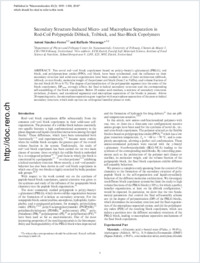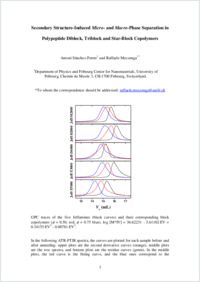Secondary structure-induced micro- and macrophase separation in rod-coil polypeptide diblock, triblock, and star-block copolymers
- Sánchez-Ferrer, Antoni Department of Physics and Fribourg Center for Nanomaterials, University of Fribourg, Switzerland - ETH Zurich, Food & Soft Materials Science, Institute of Food Science & Nutrition, Zürich, Switzerland
- Mezzenga, Raffaele Department of Physics and Fribourg Center for Nanomaterials, University of Fribourg, Switzerland - ETH Zurich, Food & Soft Materials Science, Institute of Food Science & Nutrition, Zürich, Switzerland
-
22.12.2009
Published in:
- Macromolecules. - 2010, vol. 43, no. 2, p. 1093–1100
English
Ten novel rod−coil block copolymers based on poly(γ-benzyl-l-glutamate) (PBLG), rod block, and poly(propylene oxide) (PPO), coil block, have been synthesized, and the influence on their secondary structure and solid-state organization have been studied in terms of their architecture (diblock, triblock, or star-block), molecular weight of the polymer coil block (from 2 to 5 kDa), and volume fraction of the rod block (0.50 or 0.75). The degree of polymerization of the polypeptide segment into the arms of the block copolymers, DParm, strongly affects the final α-helical secondary structure and the corresponding self-assembling of the block copolymers. Below 20 amino acid residues, a mixture of secondary structures (α-helices, β-sheets, and unordered segments) and microphase separation of the blocks is present. Above 20 repeating units, the microphase separation goes together with macrophase separation of the pure α-helical secondary structure, which ends up into an orthogonal lamellar phase or rods.
- Faculty
- Faculté des sciences et de médecine
- Department
- Département de Physique
- Language
-
- English
- Classification
- Chemistry
- License
-
License undefined
- Identifiers
-
- RERO DOC 17440
- DOI 10.1021/ma901951s
- Persistent URL
- https://folia.unifr.ch/unifr/documents/301536
Other files
Statistics
Document views: 98
File downloads:
- pdf: 238
- Supplementary material: 134

